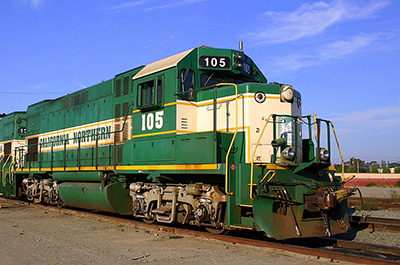ASLRRA touts potential of short line railroad tax credit being made permanent
Prospects are looking bright for a tax credit geared towards short line railroads to become permanent through a piece of House of Representatives legislation entitled the Building Rail Access for Customers and the Economy (BRACE) Act, according to the American Short Line and Regional Railroad Association (ASLRRA).
Prospects are looking bright for a tax credit geared towards short line railroads to become permanent through a piece of House of Representatives legislation entitled the Building Rail Access for Customers and the Economy (BRACE) Act, according to the American Short Line and Regional Railroad Association (ASLRRA).
The BRACE Act has 226 House co-sponsors (H.R. 721) and 51 Senate co-sponsors (S. 407).
The tax credit, which is known in railroad circles as 45G, assists the 603 short line railroads in upgrading their track and bridges in order to handle modern freight cars, explained ASLRRA, adding that under the terms of 45G a short line railroad must invest $1 for every 50 cents in credit up to a credit cap equivalent to $3,500 per mile of track while allowing the rail industry to spend more of their own revenue to make rail transport safer and more efficient for more than 10,000 United States customers.
The 45G tax credit, which expired on December 31, 2015, was implemented in 2005, and since that time the ASLRRA said that it has enabled short line and regional railroads to invest $4 billion into infrastructure, with 2,140 rail miles improved in 2015, the last year for which data was reported), 5.27 million ties replaced, with the short line industry doling out $1.12 million, or 24%, of revenue on infrastructure.
“Even in these uncertain times, the majority of our Congress is certain of one thing: the 45G short line railroad credit works, and should be made permanent,” said Linda Bauer Darr, President of ASLRRA, in a statement.
The ASLRRA has previously said the credit “represents real and immediate infrastructure investment and job creation that preserves transportation and economic development opportunities.”
And on top of that, this legislation provides myriad benefits for railroad and intermodal shippers and carriers alike.
“The real benefit is accruing to the [shipper],” said Adam Nordstrom a lobbyist for the ASLRRA and a partner in the Washington, D.C.-based law firm Chambers, Conlon & Hartwell, LLC, in a previous interview. “This…is about keeping short line railroad customers connected to the national railroad network with adequate and safe rail service, which is why this provision has such broad appeal.”
There are more than 500 short line railroad carriers in 49 states, which serve as the first and last mile for more than 11,000 rail shippers. And preserving and upgrading short line railroad tracks is critically important to so many economies and communities throughout the U.S.
When freight railroads were deregulated in the U.S. in 1980 through the Staggers Act, there were 200 short line railroads, and today there are more than 550. Deregulation in effect encouraged the creation of short lines, which would have otherwise been abandoned, and short lines were previously owned by Class I railroads whom did not want to operate them anymore, because they were not part of the Class I’s core networks and were not financially viable for them, although they were financially viable for short line operators.
What’s more, abandoned short lines had suffered from decades of deferred maintenance, which supported the point of passing the tax credit to create a way of effectively lowering the costs of infrastructure upgrades so that more infrastructure upgrades could take place and preserve rail lines that would have otherwise been abandoned.
“When you abandon a rail line, the shipper on that line loses his connection to the freight rail network and from the standpoint of Congress, it was a mindset to preserve as many miles as possible,” said Nordstrom. “Without this credit, there would have been many more abandoned miles.”
Nordstrom explained that short line railroads, as well as their customers, are allowed to earn the tax credit, and that there are lots of instances where short line railroads and their customers partner to fund infrastructure upgrades, with customers claiming the tax credit on their tax return as the entity paying for the upgrade.
“There are tens of millions of dollars per year that are actually customer-funded upgrades as opposed to solely railroad-funded upgrades,” said Nordstrom.













